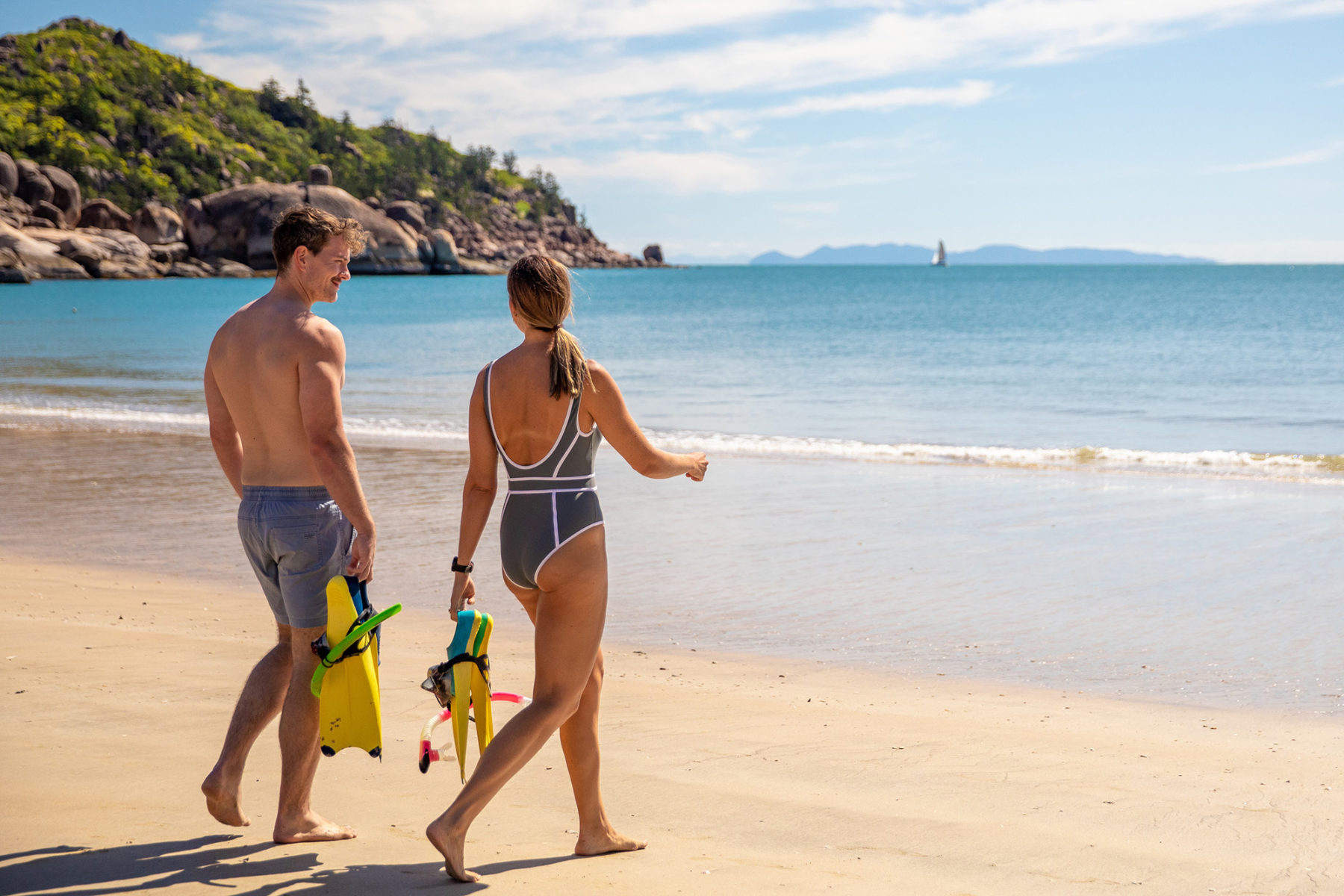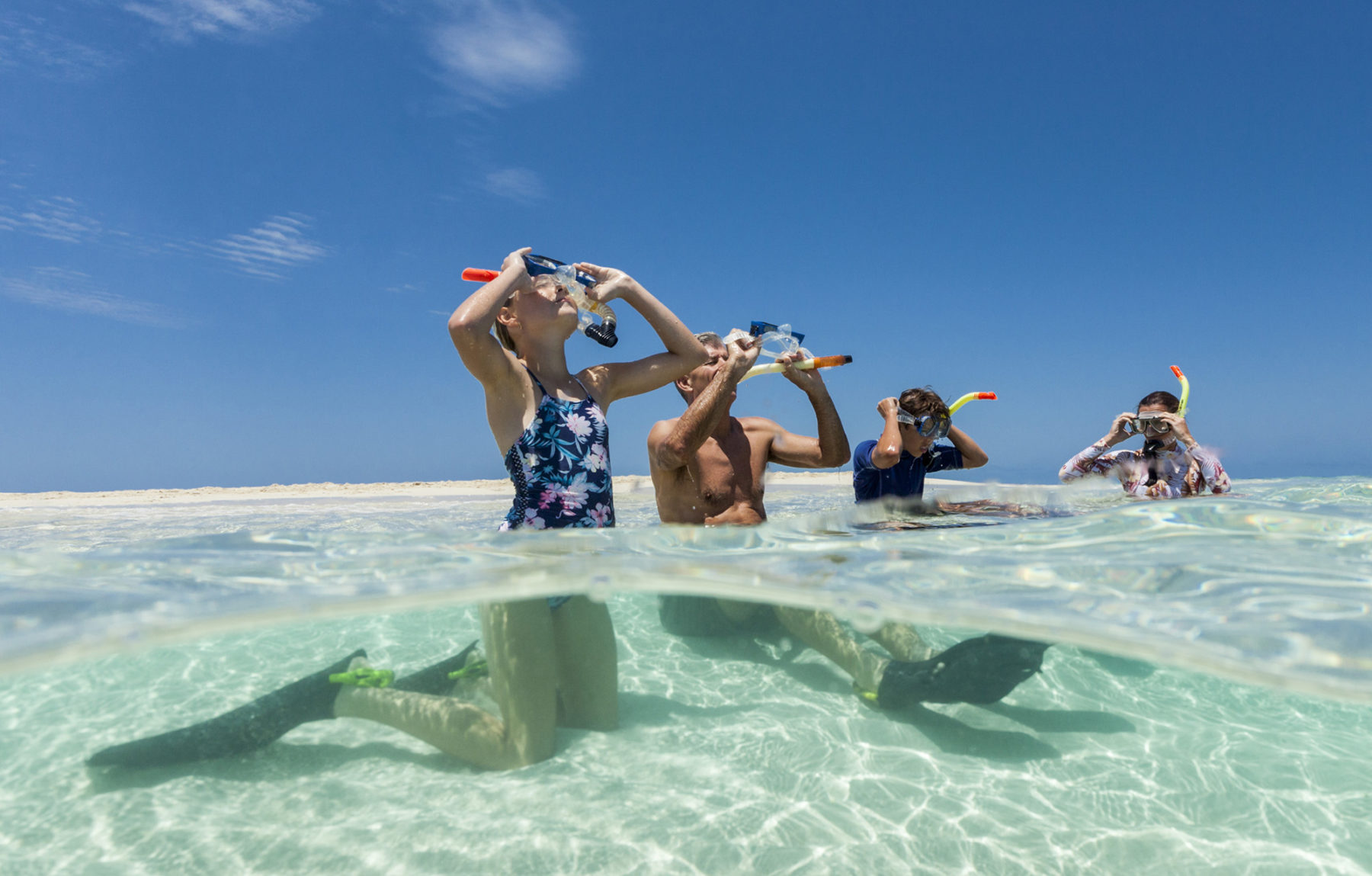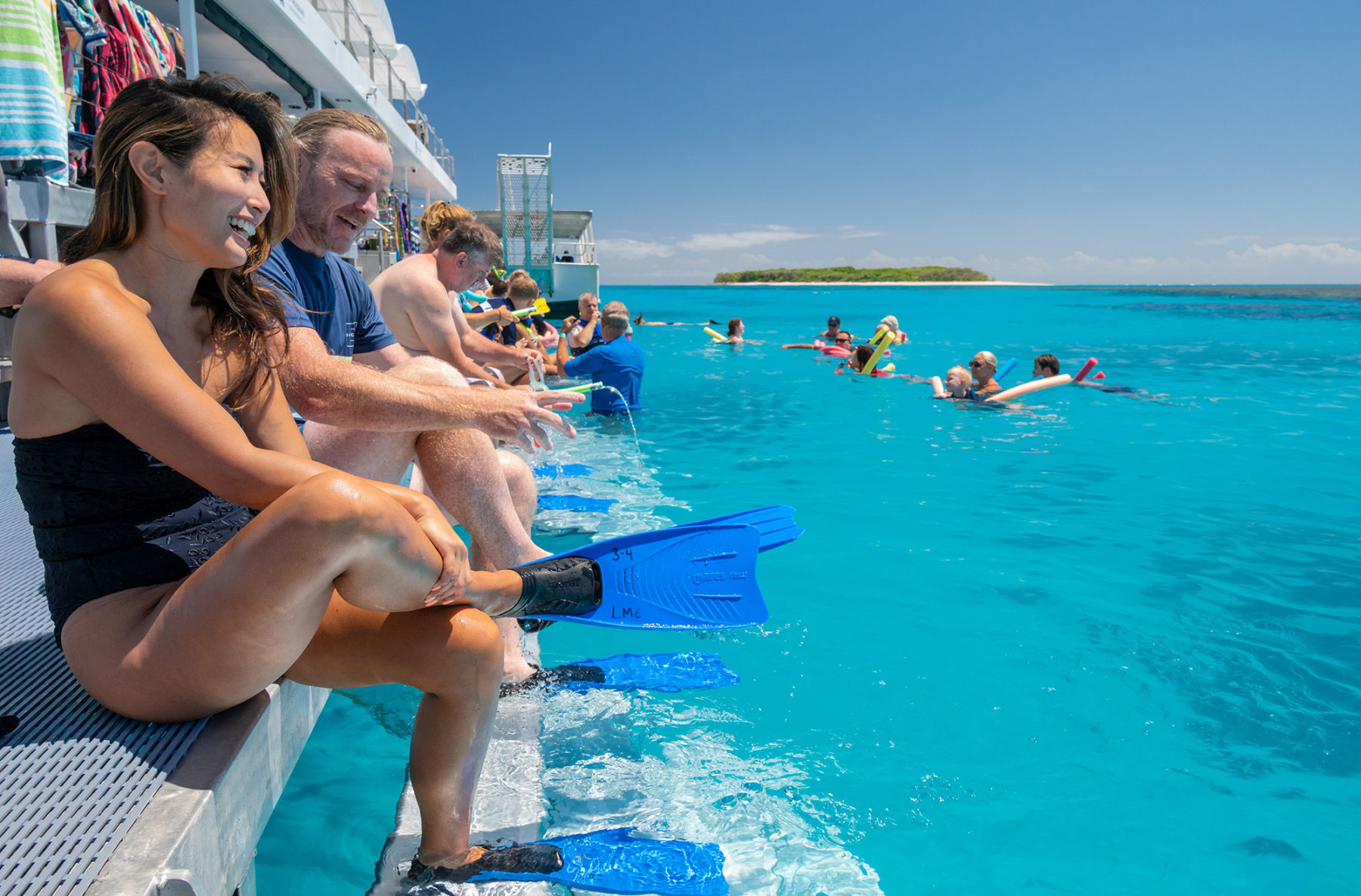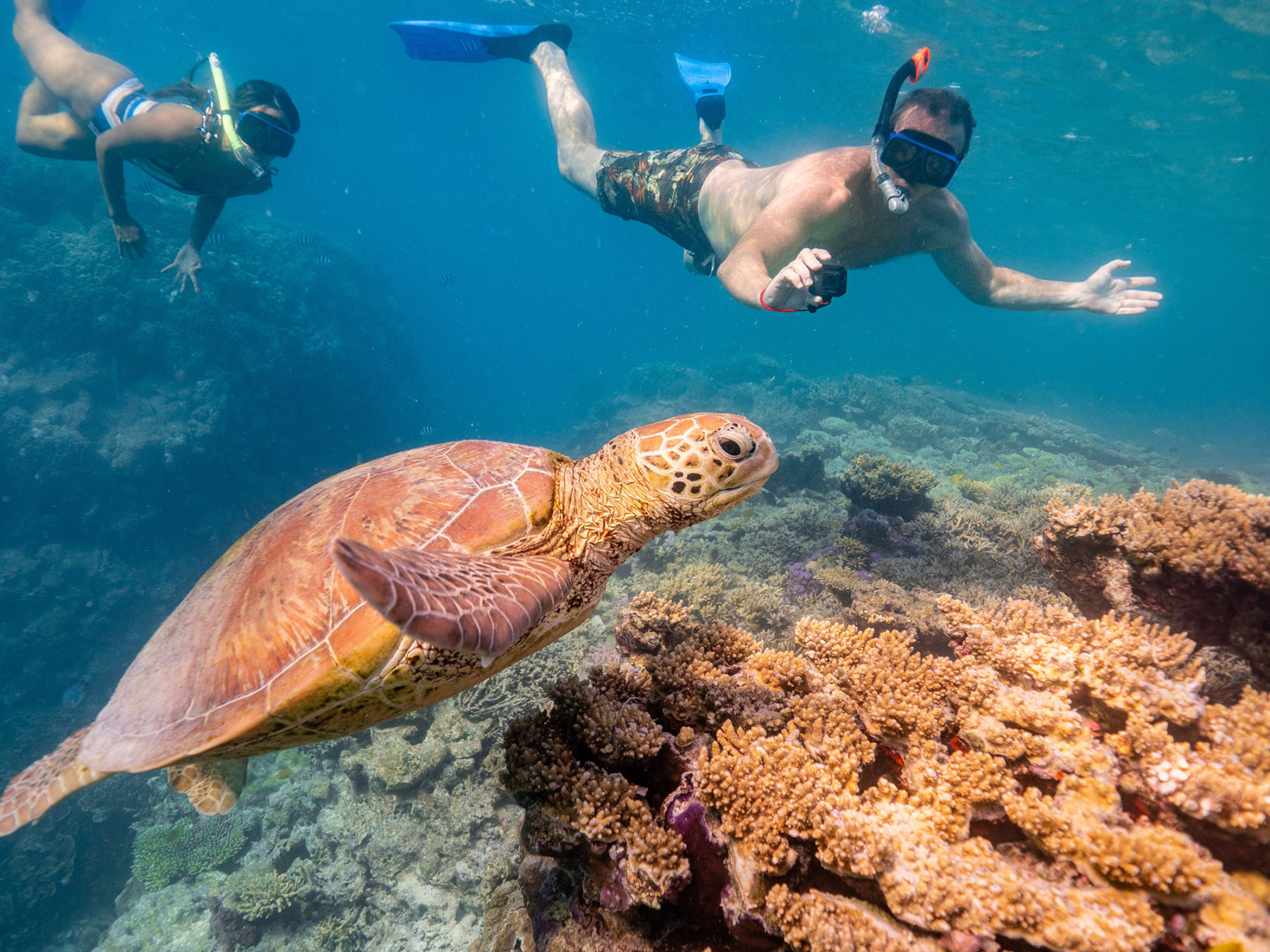Deep dive: A guide to snorkelling

There’s something about the ease and grace of snorkelling that makes it one of the absolute best outdoor activities. A tiny bit of practice, a minimal amount of gear, and you can immerse yourself in another world. Yes, I can scuba dive, but snorkelling just generally seems so much more fun than the ritual of strapping on weights, tanks and diving apparatus. The light gear is easily thrown in a daypack, and it’s an easy activity to do with family and friends. You’re not restricted by time like you are in diving and, let’s face it, on many dives the best colours, corals and sea life are in the first 10 metres anyway, so you can often see almost as much on snorkel.

Snorkelling off the Cocos (Keeling) Islands I’ve swept through schools of humbugs and tropical fish so thick it’s like swimming in an aquarium. I’ve met Nemo in the Great Barrier Reef and swum over coral palettes off Fiji. Even in the seemingly more mundane Sydney Harbour, I’ve seen blue groper, cuttlefish, big wrasse, octopus, wobbegongs, Port Jackson sharks, little diamond-back stingrays, seahorses, weedy seadragons and little things like nudibranchs and crustaceans. “The more you do it, the more you look for those little things,” says Miguel Garrido, a snorkelling, freediving and scuba instructor. “Guides do the sites every day and so they know where all the cool stuff is – and the dangerous spots.”
Miguel recommends that wherever you snorkel, if you are not with a guide, always stay with a buddy in case one of you gets into trouble. If you are freediving (breath-hold diving), the rule is that one stays on the surface while the other dives.
Tips for beginners
Whether you are taking children out snorkelling for the first time, are with people who can’t swim well, or just have always found it hard to stick your head in the water and breathe through not much more than a straw, there are a few things that can make snorkelling easier.
First, try putting a mask and snorkel on in a bath, and see if you can relax and breathe normally with your face in the water. Some people find this very difficult, but with practice (and a lot of self-talk) most people should be able to do this. Then, find a snorkelling site with easy walk-in access that gradually gets deeper. That way first timers can swim out a bit and easily retreat or put their feet down if they are panicking. On the Great Barrier Reef, an island, cay or pontoon snorkelling tour will be much easier than an outer reef experience. A pool noodle or other flotation device can help poor swimmers, giving them something to hang onto.

Slow down! The temptation for many first timers is to zoom around crazily, which can scare off many creatures and you’ll miss smaller, hidden things. Don’t just look straight ahead or down: practise looking to the sides and occasionally behind you as sometimes larger fish will creep up on you.
“A lot of people come and are worried about sharks,” says Jack Glennon, a senior dive instructor. “But they’re amazing creatures and they’re not here to endanger us whatsoever.” On the reef, the most common sharks are blacktip, whitetip and grey reef sharks – and it’s worth remembering that objects appear about one-third larger underwater (so that “2m shark” you were raving about is probably only a bit over a metre).
Buy decent gear. It’s tempting to buy the $40 Kmart snorkelling pack, but if a mask doesn’t fit properly and the crappy rubber seal lets in water, you won’t see much and you won’t have a good experience. Good gear rinsed well after each use can last for many years – my dive mask, snorkel and fins are two decades old and still as useful as the day I bought them.
Snorkels
Expect to pay $40 to $120 for a decent snorkel. Many now have a small reservoir and purge valve at the bottom. This means that if a small amount of water collects inside the snorkel, you can blow it out the bottom without taking your face out of the water. “Shouting ‘two’ always works – if you make the ‘t’ sound it just works better,” Jack says. Other features on snorkels include splash guards to prevent water coming in the top, and auto-closure devices at the top that will prevent water from coming in the snorkel even if you go completely underwater. Most divers and experienced snorkelers don’t want these extra features though, as they are one more thing that could possibly break or fail.
Miguel says the most common mistake he sees with snorkels is people fitting them to the mask incorrectly. “Snorkels are typically designed to go on the left side, because a diver’s regulator goes on the right, so a lot are angled specifically for that left-hand use,” he says.
Masks
A few years ago, most divers were taught that you check a mask is a good fit by sticking it on your face and breathing in deeply through your nose. If the mask stuck to your face, then it was a good fit, so the theory went. Not so. “I can get a kid’s mask and breathe in and it’ll stay on my face, so it’s not a good test,” Jack says.
Instead, tilt your head back and place the mask on your face with no external pressure. You should be able to check (or have a friend look) whether there are large gaps between your face and the mask’s ‘skirt’. Some silicone can be black, which many beginner snorkelers don’t like as it doesn’t let in as much light and they can feel a little claustrophobic. The whole skirt should be made of 100% silicone – not silitex or rubber. Good masks – which will set you back $80–$180 – should have a second, inner seal.
Masks always need to be defogged, or cleared, before entering the water. Most people just spit in them, rub the spit around the inner lens, and then rinse it out. Dive shops also sell special formulas to do this. However, research by a science class on the Northern Beaches of Sydney has shown that the best anti-fog agent is a few drops of Johnson’s No More Tears Baby Shampoo smeared on the mask’s inside, then rinsed out.
Fins
Long, short, split, hard, soft, full-foot, heel-free – there’s such a huge range of fins out there it can be confusing. Snorkelling-specific fins are usually quite short and inflexible, and not necessarily suitable if you want to use them for diving as well. Freediving fins, however, are generally very stiff and very long. (For our ultimate guide to free diving, see here.)
Full-foot fins start from about $60, but they often suit narrow feet better than broad feet, and can cause rubbing or blisters, particularly if a grain of sand or grit gets in. Open-heel fins require the wearer to also buy neoprene booties, but Miguel says booties are ideal to protect your feet “if you’re snorkelling something like Bare Island, where you’re walking in off the rocks”.

He says one of the most dangerous things he sees is people running with fins on. “Don’t put your fins on until you’re at the water’s edge or, if there are no currents, when you’re actually in the water – go in about waist deep, then rock back and put them on. If you do have to walk around in them, walk backwards.”
Jack says some people have no idea in the water about how to kick. “They almost use their legs like they’re on a bicycle, which causes their fins to just stab in the water,” he says. The best and most economical kicking style for most fins is long, strong and slow kicks from the hips, keeping the legs straight. Split fins can suit more of a faster ‘normal’ kicking style, more akin to freestyle.
Snorkelling photography
Sick of washed out, blurry blue photos when snorkelling? As red is the first spectrum to be lost when you descend, the easiest and cheapest solution to get better colours is to buy a clip-on red filter. If the water is greenish, you may need a purple filter.

Next simple solution is to make sure the camera is held steady. “People generally attach them to their head, but there’s so much movement you do with your head,” Miguel says. Instead, he recommends a selfie stick or cradle.
“But the absolute best way to get colour is to bring light down with you – something with a wide beam so it’s not hot-spotting particular areas,” he says.

